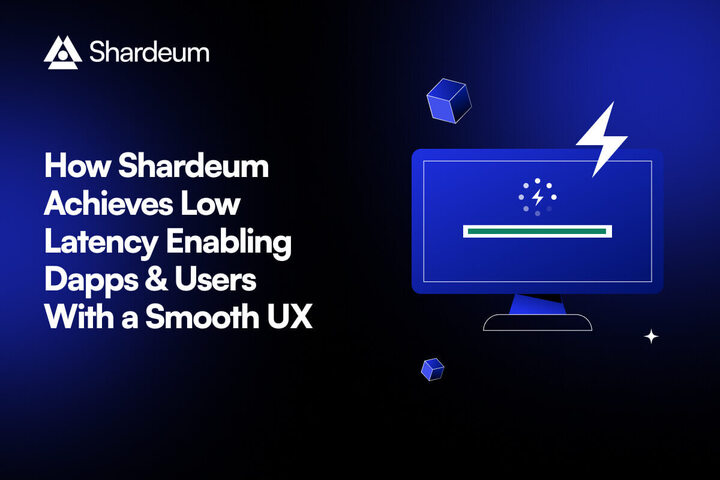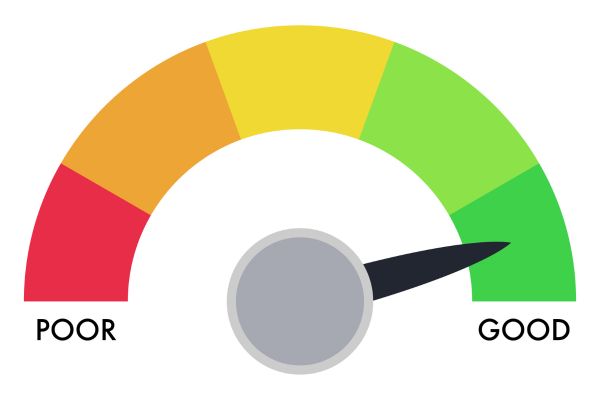Shardeum's Low-Latency Magic for Seamless Dapp Experiences
 Nikhil Kumar
Nikhil KumarTable of contents

1. Introduction
Latency is a fundamental concept in the world of computer networks and data transmission. It represents the time it takes for information or data to travel from its starting point (the source) to its intended endpoint (the destination). In essence, latency is the measure of delay or lag in the communication process between two points within a network.
Network latency, specifically, is the delay or lag that occurs when data is transmitted from one point in a network to another point within the same network or over the internet. It's crucial to understand network latency because it directly impacts the responsiveness and performance of various online activities, applications, and services.
2. Low Latency Unleashed: The Game-Changer for Seamless Digital Experiences
2.1 The Power of Low Latency
In the world of technology, there's a magic spell that can make the digital universe respond at the speed of thought—it's called low latency. Imagine a world where the lag between hitting a key and seeing the action happen on your screen is so short that it's virtually imperceptible. That's what low latency does; it minimizes the delay between sending data and receiving it. It's not just a fancy tech term; it's the secret sauce that transforms everyday experiences into seamless, lightning-fast interactions.
2.2 Low Latency's Universal Impact
Now, let's talk about where this enchanting concept of low latency works its wonders. Whether you're a financial whiz executing lightning-fast trades, a gamer navigating a virtual battlefield, or just someone making a crystal-clear video call, low latency is your trusty sidekick. In the financial industry, it's the difference between profit and loss, where even a few milliseconds can mean millions. For gamers, it's the edge that turns defeat into victory, ensuring your actions in the game world are mirrored instantly. And in telecommunications, it's the bridge that connects people across the globe in real-time. In short, low latency isn't just a luxury; it's the heartbeat of real-time systems.
Paragraph 3: Shardeum's Low Latency Revolution
Enter Shardeum, a game-changer in the world of blockchain. Historically, the blockchain industry has grappled with latency issues, but Shardeum, as an L1 network, is rewriting the rules. It's on a mission to maintain ultra-low latency in a space where speed is everything. Imagine smart contracts executing in the blink of an eye, decentralized applications responding in real-time, and a blockchain ecosystem that doesn't keep you waiting. Shardeum's commitment to low latency is poised to redefine what's possible in blockchain technology, ensuring that it doesn't just meet, but exceeds the expectations of the modern, fast-paced world. Welcome to a future where blockchain is as swift as thought itself.
3. The Blockchain Trifecta: Latency, Finality, and Scalability Unveiled
3.1 Latency: In the realm of blockchain, latency refers to the time it takes from the moment a valid transaction is submitted to the blockchain network until the network processes and confirms that transaction. It represents the total turnaround time for a single transaction to be acknowledged by the network. Low latency is essential for ensuring that transactions are swiftly processed, providing users with a seamless and responsive experience. It's worth noting that while low latency is important, it doesn't guarantee the permanence or immutability of the transaction, which brings us to the concept of finality.
3.2 Finality: Finality in blockchain refers to the point at which a confirmed transaction becomes irreversible and cannot be altered or removed from the blockchain. It represents the ultimate assurance that a transaction has been successfully incorporated into the blockchain's immutable ledger. Finality time, therefore, is the total time it takes for a transaction to be submitted, processed, and considered unchangeable by the network. Achieving rapid finality is crucial for ensuring the security and trustworthiness of blockchain-based systems, as it ensures that once a transaction is confirmed, it is etched in stone.
3.3 Scalability: Scalability, on the other hand, is a broader concept that complements both latency and finality. It relates to the ability of a blockchain network to handle a substantial volume of transactions concurrently. This capacity is typically measured in transactions per second (TPS). While low latency minimizes the time taken to process individual transactions, scalability focuses on the network's overall capacity to manage a high number of transactions simultaneously. Scalability is essential for accommodating the growing demands of blockchain applications, making them suitable for widespread adoption in various industries.
In essence, while latency emphasizes the speed of processing individual transactions, finality underscores the irreversible nature of confirmed transactions, and scalability addresses the network's capacity to handle a significant volume of transactions concurrently. All three factors—latency, finality, and scalability—are pivotal in shaping the efficiency, reliability, and usability of blockchain networks, particularly in scenarios where a high number of transactions must be processed swiftly and securely.

4. Latency Showdown: Web2 vs. Web3 Networks
In the dynamic realm of digital networks, latency is a kingmaker, determining the speed and responsiveness of transactions. When comparing centralized networks, which include private blockchains, to decentralized blockchain networks, a fascinating latency divide comes to the forefront.
4.1 Centralized Networks: These systems, characterized by a single controlling entity or organization, enjoy the privilege of lower latency. Why? Because there's no need for multiple parties to reach a consensus on transaction validity. Instead, the processing and validation happen swiftly, thanks to centralized servers. Latency in this realm hinges on factors like the efficiency of software, the speed and capacity of the server's hardware, and network conditions. Through tactics such as load balancing and meticulous network maintenance, these entities tackle latency by scaling vertically, essentially boosting their system's processing power.
In the world of centralized networks, speed is a resource they can harness at will, providing users with rapid transaction experiences that leave little room for delay.
4.2 Decentralized Networks: Conversely, in the world of decentralized blockchain networks, latency can sometimes be more pronounced. The essence of decentralization means that multiple participants must reach a consensus on the validity of transactions. While this introduces a layer of verification and trust, it can also lead to slightly longer latency times. Decentralized networks strive to minimize latency through optimization techniques, protocol enhancements, and consensus algorithm improvements.
The trade-off, however, is a network that thrives on principles of trust, transparency, and security. While it may not always match the lightning-fast pace of centralized networks, it offers something even more valuable: a distributed, tamper-resistant ledger that redefines how we interact with data and value.
In essence, the latency divide between centralized and decentralized networks reflects a fascinating trade-off between speed and trust, offering users a choice between rapid transaction processing and the resilience of a trustless, decentralized ecosystem.
5. The Impact of Higher Latency on the Blockchain Industry Today:
1. Scalability Trilemma Challenges: Solving the scalability trilemma in blockchain networks has become a formidable challenge. Decentralized networks, while championing security and decentralization, grapple with latency due to their consensus algorithms and variable block sizes. These factors, while safeguarding against centralization and attacks, introduce inherent delays. Consequently, decentralized blockchains face hurdles in real-time applications like gaming, supply chains, and healthcare. The race is on among newer networks to strike the balance between security, decentralization, and scalability.
2. Inverse Relationship of Latency and Throughput: In the intricate world of blockchain networks, the relationship between latency and throughput is inversely proportional. As latency and finality time increase, throughput, or the ability to process a high number of transactions per second (TPS), decreases. While traditional systems exhibit this phenomenon, blockchain networks add complexity to smart contracts and consensus mechanisms. Low latency takes centre stage, surpassing even bandwidth requirements in shaping a network's scalability and throughput.
3. Escalating Transaction Costs: Vertical scalability limitations, low TPS, and unsolved scalability trilemma culminate in high transaction costs and gas fees. These costs surge as network traffic intensifies, exacerbating the situation with higher latency. Users and dapp developers alike are burdened by increased computation and communication costs, undermining the promise of decentralization and compromising accessibility.
4. MEV and Front-Running Risks: Public blockchains expose transactions transparently, inadvertently incentivizing validators to prioritize high-fee transactions. While manipulating the entire market remains challenging, malicious actors engage in front-running, profiting from price differences. Low latency and immediate finality prove pivotal here, making it harder for such actors to exploit transactions. The crypto market's collateral damage can be extensive when these manipulations occur.
5. Suboptimal User Experience (UX): Mass adoption of blockchain hinges on positive user experiences and low transaction costs. Unfortunately, current blockchain ecosystems often lack these qualities. High latency and slow finality deter users and introduce inefficiencies in decentralized crypto exchanges (DEXs), contrasting them unfavourably with centralized counterparts. The resultant bad UX perpetuates liquidity issues and market volatility.
6. Security Attacks: While L1 blockchains prioritize high security and decentralization, solutions and dapps built on them sometimes compromise these principles for user-friendliness. Security threats like phishing scams, malware attacks, and DoS attacks loom. Low latency mitigates the risk of DoS and DDoS attacks, as attackers must send more transactions to overwhelm the network. In essence, low latency fortifies blockchain networks against sophisticated security attacks.
In summary, latency's multifaceted impact on the blockchain industry touches on scalability, transaction costs, security, and user experience, making it a pivotal factor in shaping the future of blockchain technology.
The Good News – Bigger Picture
The positive development for public blockchain networks and the broader Web3 ecosystem is their innate emphasis on inclusivity, welcoming participation from individuals in various roles, including validators, smart contract developers, and storage providers. This inclusivity sets them apart from their Web2 counterparts, where power predominantly resides in the hands of companies that own and operate data centres and cloud servers. In contrast, contemporary blockchain protocols are strategically designed to address the scalability trilemma by prioritizing scalability right from their foundational architecture. They incorporate optimal consensus mechanisms and innovative techniques like auto-scaling, all aimed at achieving robust scalability.
6. Shardeum's Low Latency Revolution: Unraveling the Secret Sauce

Shardeum is an EVM-based layer 1 smart contract platform which is currently in its betanet stage of the project. On Shardeum, consensus will be done at the transaction level instead of the block level and transactions will be processed parallelly through dynamic state sharding with a latency of very few seconds. Well that’s a mouthful, isn’t it? Ok let’s break it down in simple words. And we’ll engage you with a chronological elaboration from the perspective of blockchain technology so you can see the complete picture.
1. High Fairness & Transaction-Level Consensus:
Shardeum, an EVM-based layer 1 smart contract platform, has cracked the code to low latency by revolutionizing how transactions are processed. Validators on Shardeum adopt a "first come, first served" approach, virtually eliminating the complexities of MEV and front-running. Unlike traditional blockchains where transactions are grouped into blocks and processed sequentially, Shardeum takes a different path. Here, each transaction undergoes individual validation, consensus, and processing, ensuring a remarkably swift process.
2. Immediate Finality:
What sets Shardeum apart is its commitment to immediate finality. Unlike other blockchains that offer probabilistic or absolute finality and require confirmation from multiple blocks, Shardeum provides finality for each confirmed transaction without delay. This innovative approach significantly reduces the need for waiting periods, offering users a seamless experience. In Shardeum, confirmed transactions are subsequently grouped and moved to archive nodes, allowing validator nodes to store only the current state of accounts within relevant shards.
3. Dynamic State Sharding & Parallel Transaction Execution:
Shardeum's dynamic state sharding, coupled with its auto-scaling capability, is a game-changer. The network adapts the number and size of shards dynamically based on the existing workload. Since consensus happens at the transaction level, even transactions affecting multiple shards are processed simultaneously, not sequentially. This not only accelerates transaction processing times, especially for cross-shard transactions, but also ensures atomic processing with a network latency of just a few seconds.
4. Equal Distribution of Workload:
Shardeum's leaderless consensus mechanism bolsters network security and decentralization by regularly rotating validator nodes. This strategic approach ensures an equitable distribution of workload among network resources while maintaining operational efficiency. In the sharded environment, Shardeum thrives on balance and fairness.
5. Linear Scalability & High Performance:
The crown jewel of Shardeum's innovation is its linear scalability, a departure from vertical scaling common in other networks. Every node or shard added to the network from the standby nodes pool proportionally enhances its transaction processing capacity during periods of high traffic. This linear scalability guarantees predictable network overheads, including latency, finality, and gas fees, even when handling complex smart contract transactions.
7. Conclusion:
In a nutshell, Shardeum's groundbreaking approach to consensus, immediate finality, dynamic state sharding, workload distribution, and linear scalability collectively spearheads its mission to deliver unparalleled low latency and high-performance blockchain solutions, effectively solving the scalability trilemma in the process.
8. FAQs: Low Latency Explained
1. Why is Low Latency Important?
- Answer: Low latency is essential because it minimizes the delay in data transfer, leading to a quicker and more efficient online experience. This is especially critical in applications like online gaming, high-frequency trading, and healthcare, where receiving data in real-time can have life-changing implications.
2. Is Low Latency Good?
- Answer: Absolutely. Low latency is generally considered good because it results in faster and more efficient data transfer, creating a smoother online experience. However, the degree of "goodness" varies depending on the specific use case, as different applications have distinct latency requirements.
3. Does Low Latency mean Faster?
- Answer: Yes, low latency equates to faster data transfer, leading to a speedier online experience. The reason is that low latency reduces the delay in data transfer, enabling more real-time interaction between applications and users. In simple terms, lower latency means less waiting and more responsiveness.
If you are interested in learning more about Shardeum or getting involved in the project, you can join the community on the Telegram channel, follow the Twitter page and join the Discord channel. You can also find more information on the Shardeum Website.
Shardeum Rewards Developers for Their Contributions.
Shardeum, the decentralized application platform, is committed to rewarding developers for their contributions to the project. The company offers a variety of community reward programs.
To learn more about the available community reward programs, please visit the Community Reward Programs page.
Thank you for Reading! ❤️
Subscribe to my newsletter
Read articles from Nikhil Kumar directly inside your inbox. Subscribe to the newsletter, and don't miss out.
Written by
